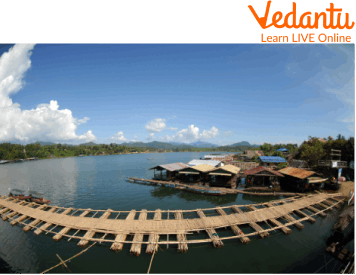




An Overview on Bridges - History & Types
A bridge is a construction designed to span a physical impediment (such as a body of water, valley, road, or rail) without impeding traffic below. It is built to allow passage over an obstacle, which is usually something that would be difficult or impossible to cross otherwise. Bridges are an essential part of a country's infrastructure because they enable the transportation of goods to factories, warehouses, suppliers, distributors, stores, and final consumers. Bridges also ease travel, allowing people to shop for goods and services both within and outside of their communities. Now let’s understand more about bridges.
History of Bridges
The first bridges were most likely constructed from fallen trees and stepping stones. Boardwalk bridges over marshes were built by Neolithic people. One of the oldest arch bridges still in use is the Peloponnese's Arkadiko Bridge, which dates to the 13th century. At this time, timber structures were also constructed. In the middle ages, bridges were predominantly made of wood and they could attain great lengths. The most important bridge in medieval Europe was the bridge of Ponte Vecchio in Florence, Italy. In the 19th century iron and steel replaced stone as construction materials for bridges. Today, concrete is used for many large bridges and other arch bridges are built with metal or reinforced concrete frames.
Types of bridges for Kids
Let's now see the types of bridges in detail
Arch bridges
Around 1,000 stone arch bridges were built by the Romans; some of these structures, like the Pont-Saint-Martin bridge in the Aosta Valley of Italy (built in the first century BCE), are still standing. This bridge's design dates back more than 3,000 years. Modern arch bridges are increasingly being built with concrete.
A bridge's load is made up of the weight of the bridge itself (referred to as the dead load) and anything it is carrying (referred to as the live load). Instead of relying on the forces of weight and gravity to keep a bridge from sliding downhill, an arch bridge uses these forces to support itself.

Arch Bridge
Bamboo Bridges
Bamboo is used to construct bamboo bridges. They are designed to serve short-term needs. They are not very sturdy because they are only meant to be worn while walking. They typically reside in rural areas.
Bridges made of bamboo are constructed using rope and bamboo sticks. For ease of passage through them, it is typically built over a river or a valley.

Bamboo Bridge
Beam Bridges
Beam bridges are the oldest and simplest type of bridge, consisting of vertical piers and horizontal beams, such as a plain board or stone block. The strength of a beam bridge is determined by the route and multiplied by the number of piers added. Beam bridges are frequently used to help large vehicles and trains cross, and some are also made for people to walk on.

Beam Bridge
Truss Bridges
A truss bridge is a bridge whose load-bearing superstructure is made up of trusses, which are connected pieces that commonly form triangle units. In reaction to dynamic loads, the connecting elements may be stressed by tension, compression, or both. Military operations have made use of truss bridges, particularly where steep riverbanks or open navigation are required. They are frequently made of transportable panels that may be quickly put together.

Truss Bridge
Why do We need Bridges?
There are many uses of bridges since they connect two sites by valleys, rivers, lakes, and cliffs.
Bridges are required for land transportation infrastructure because they connect otherwise unreachable points.
Bridges enable the means to travel long distances in addition to helping to ensure safety. Bridges are also used for tourism or traveling safely.
Bridges help people to get across rivers and oceans and even mountains.
One of the reasons that bridges are so useful is because they create a strong structure that can carry heavy loads with little damage.
Bridges also increase road safety by protecting against vehicles and enabling safe access for pedestrians.
With the increase in population, more bridges are being built to improve transportation from one place to another.
Summary
We have already discussed the types of bridges, uses of bridges and why we need bridges. A bridge is a horizontally spanning structure that allows humans and vehicles to cross a void. The beam (or girder) bridge is the most basic type of bridge, consisting of straight, inflexible beams of wood, steel, or concrete set over a span. The rounded arch design of ancient Roman bridges allowed for much larger spans than stone beams and was more durable than wood. The 4 main types of bridges are Arch bridges, bamboo bridges, beam bridges, and truss bridges. The construction of each type of bridge varies from one another. We hope you enjoyed reading this article, in case of any other doubts feel free to ask in the comments.
FAQs on Bridges: Linking Two Paths Together
1. Name some famous bridges in India.
Some of the famous bridges in India include the following:
Howrah Bridge - West Bengal
Pamban bridge - Tamilnadu
Dibang river bridge - Arunachal Pradesh
2. How is a cement bridge different from a bamboo bridge?
A cement bridge is made up of bricks, cement, and iron rods. A bamboo bridge, however, is constructed from bamboo poles, ropes, and sticks. As a result, a cement bridge is more durable than a bamboo bridge and can accommodate more traffic.
3. List several types of suspension bridges.
A suspension bridge or a wire rope bridge is a type of suspension bridge where cables are suspended from trusses to support them. It has been used since ancient times, particularly in China and Egypt. Some of the other types of suspension bridges include Martello towers built during World War II wherein cables suspend a deck between towers built on opposing sides of a body of water, arch bridges, and beam bridges.





















